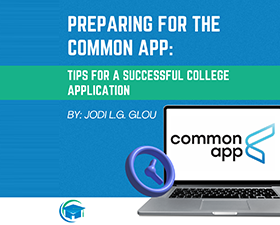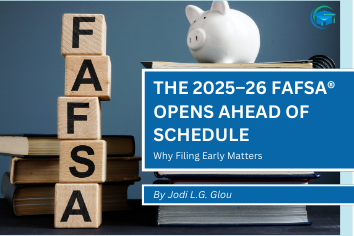Planning Ahead: A Step-By-Step Guide to College Financial Aid

When families think about the college process, the focus often lands on applications, essays, and test scores. But one of the most important, and sometimes most stressful, parts of the journey is navigating financial aid. My goal in working with families is to reduce both student stress and parent anxiety, helping you make informed, confident decisions about paying for college while balancing long-term goals like retirement.
By incorporating valuable insights from Melissa Mieyr of InfoQuest College & Financial Solutions, who specializes in the financial aid process, my hope is that the following information will equip families with practical strategies and greater confidence as they navigate the financial side of college planning. Her expertise in reviewing award letters, comparing offers, clarifying loan options, and advising on appeals provides guidance that is beneficial to all college-bound families.
Step One: Build a Comprehensive List with Fit in Mind
Before we talk numbers, remember that choosing colleges is about more than cost. A good list considers academic fit, social and emotional fit, and financial fit. All three are equally important in ensuring that a student thrives once they’re on campus.
Step Two: Understand the True Cost of College
When families ask, “What does college cost?” the answer is: it depends. Costs vary widely from one institution to another, so always check the college’s own website. And don’t just look at the first year—consider all four years, factoring in annual tuition increases of 3–8%.
- Average Cost of Attendance (per year)
- $30,000 for in-state public universities
- $60,000 for out-of-state public universities
- $90,000 for private/elite universities
- Direct Costs (paid directly to the school)
- Tuition and fees
- Room and board
- Indirect Costs (other expenses to plan for)
- Books and supplies
- Transportation
- Personal expenses
Step Three: Complete Your Financial Aid Applications
Financial aid begins with paperwork. The FAFSA (Free Application for Federal Student Aid) determines federal eligibility, while some schools also require the CSS Profile to determine institutional aid. Both open on October 1st, and deadlines often align with admissions applications—don’t miss them.
- The FAFSA calculates your SAI (Student Aid Index), formerly known as the EFC. This number determines your eligibility for need-based aid.
- What counts? Primarily income. The “prior-prior year” tax return is used, meaning the Class of 2026 will use their 2024 tax form.
- Assets matter, but student income is only assessed after a protection allowance ($11,770 for the 2025-2026 school year).
📅 Tip: Your “base year” for financial aid actually starts halfway through sophomore year of high school and runs through the first half of junior year. During this time, try to avoid moves that inflate income, such as:
- Retirement plan distributions
- Employment bonuses
- Exercising stock options
- Converting UGMA/UTMA accounts to 529s
- Getting remarried
- Students earning above the allowance
Step Four: Know the Types of Aid Available
Financial aid comes in several forms:
- Need-Based Aid – Based on financial eligibility (Cost of Attendance -SAI = Cost of Attendance).
- Merit Aid – Based on academic, athletic, or talent achievements, regardless of financial need.
- Self-Help Aid – Includes work-study and student loans.
How families fit:
- High Merit / Low Need – Non-need-based merit aid, private scholarships.
- High Merit / High Need – Combination of need-based aid, merit aid, and private scholarships.
- Low Merit / High Need – Schools that meet 100% of need, SAI reduction strategies, timely applications are key.
- Low Merit / Low Need – Limited aid options; private scholarships may help.
Step Five: Review, Compare, and Appeal Award Letters
Once admissions decisions arrive, families must carefully review award letters. This is where I work with parents and students to:
- Compare offers side by side
- Understand loan terms
- Identify hidden costs
- Appeal when necessary
This step ensures families feel informed and confident before making final decisions.
Legislative Changes You Should Know
Recent updates in financial aid legislation have introduced new borrowing limits:
- Parent PLUS Loans – Now capped at $65,000 total for an undergraduate degree.
- Repayment Options – Federal rules have streamlined repayment into just two primary options, limiting flexibility for families.
Staying on top of these changes is essential to avoid unexpected financial strain later.
Final Thoughts
Paying for college can feel overwhelming, but with the right plan, it becomes manageable. By creating a budget, analyzing your financial profile, building a thoughtful school list, and staying ahead of deadlines, families can approach this process with confidence.
Ultimately, financial aid is about more than numbers—it’s about creating opportunities. At Custom College Consulting, we believe that when families approach the process with clarity and preparation, they can focus less on the stress of costs and more on finding the right college fit. With the right strategies in place, students are empowered to pursue their goals, and parents can move forward with confidence knowing they’ve built a sustainable plan for the future.










